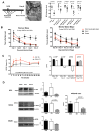Neutrophil depletion after subarachnoid hemorrhage improves memory via NMDA receptors
- PMID: 26872422
- PMCID: PMC4828315
- DOI: 10.1016/j.bbi.2016.02.007
Neutrophil depletion after subarachnoid hemorrhage improves memory via NMDA receptors
Abstract
Cognitive deficits after aneurysmal subarachnoid hemorrhage (SAH) are common and disabling. Patients who experience delayed deterioration associated with vasospasm are likely to have cognitive deficits, particularly problems with executive function, verbal and spatial memory. Here, we report neurophysiological and pathological mechanisms underlying behavioral deficits in a murine model of SAH. On tests of spatial memory, animals with SAH performed worse than sham animals in the first week and one month after SAH suggesting a prolonged injury. Between three and six days after experimental hemorrhage, mice demonstrated loss of late long-term potentiation (L-LTP) due to dysfunction of the NMDA receptor. Suppression of innate immune cell activation prevents delayed vasospasm after murine SAH. We therefore explored the role of neutrophil-mediated innate inflammation on memory deficits after SAH. Depletion of neutrophils three days after SAH mitigates tissue inflammation, reverses cerebral vasoconstriction in the middle cerebral artery, and rescues L-LTP dysfunction at day 6. Spatial memory deficits in both the short and long-term are improved and associated with a shift of NMDA receptor subunit composition toward a memory sparing phenotype. This work supports further investigating suppression of innate immunity after SAH as a target for preventative therapies in SAH.
Keywords: Cerebral vasospasm; Delayed neurological deterioration after subarachnoid hemorrhage; Innate inflammation; Memory deficits; Neutrophils; Subarachnoid hemorrhage.
Copyright © 2016 Elsevier Inc. All rights reserved.
Conflict of interest statement
Figures



References
-
- van Gijn J, Rinkel GJ. Subarachnoid haemorrhage: diagnosis, causes and management. Brain. 2001;124(Pt 2):249–278. - PubMed
-
- Macdonald RL, Higashida RT, Keller E, et al. Clazosentan, an endothelin receptor antagonist, in patients with aneurysmal subarachnoid haemorrhage undergoing surgical clipping: a randomised, double-blind, placebo-controlled phase 3 trial (CONSCIOUS-2) Lancet Neurol. 2011;10(7):618–625. - PubMed
-
- Hop JW, Rinkel GJ, Algra A, van Gijn J. Changes in functional outcome and quality of life in patients and caregivers after aneurysmal subarachnoid hemorrhage.[see comment] Journal of Neurosurgery. 2001;95(6):957–963. - PubMed
-
- Barker FG, 2nd, Ogilvy CS. Efficacy of prophylactic nimodipine for delayed ischemic deficit after subarachnoid hemorrhage: a metaanalysis. J Neurosurg. 1996;84(3):405–414. - PubMed
-
- Frontera JA, Fernandez A, Schmidt JM, et al. Defining vasospasm after subarachnoid hemorrhage: what is the most clinically relevant definition? Stroke. 2009;40(6):1963–1968. - PubMed
Publication types
MeSH terms
Substances
Grants and funding
LinkOut - more resources
Full Text Sources
Other Literature Sources
Medical

